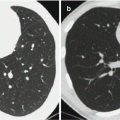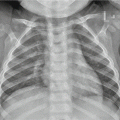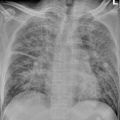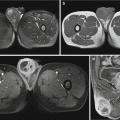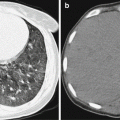Fig. 5.1
Micrograph of Chlamydophila (Chlamydia) pneumoniae in an epithelial cell in acute bronchitis: 1 infected epitheliocyte, 2 uninfected epitheliocytes, 3 chlamydial inclusion bodies in cell, 4 cell nuclei
5.1.2 Features Found by Culture
CP can only parasitize in cells and cannot be cultured in vitro. Therefore, cell subculture is commonly used for its reproduction. The sensitive cell lines to CP include HEP-2 and H-292.
5.1.3 Antigenicity
CP has genus-specific antigen and species-specific antigen. So far only one serotype of CP has been found, and the DNA homogeneity of different CP strains isolated in different regions of the world is above 94 %. The restriction endonuclease maps of different CP strains are basically identical, with standard strains of TW-183 and AR-39. The standard strains have been demonstrated to be the same strain and is renominated as TWAR.
5.1.4 Resistance
Chlamydia is tolerant to cold but intolerant to heat. Only 1 % of CP can survive in the blood preserved at a room temperature of 22 °C for 24 h. About 77 % of CP can survive at a temperature of −75 °C for 3 days. CP has low virulence and the bacteria within three generations are not lethal for chicken embryos. Its antibacterial spectrum against drugs resembles to other chlamydia and it is resistant to sulfa drugs.
5.2 Epidemiology
5.2.1 Source of Infection
CP is only parasitic in humans and it has no animal hosts as its reservoir. Therefore, the patients with CP infection, human carriers of CP, and asymptomatic patients with CP infection are the sources of its infection. Its average incubation period lasts for about 30 days.
5.2.2 Route of Transmission
CP spreads to the surrounding air via droplets by sneezing, coughing, and talking or via respiratory secretions. The inhalation of the droplets by susceptible people causes the infection. Otherwise, contaminated hands by these droplets in the environment also cause the infection.
5.2.3 Susceptible Population
People with no history of CP infection are all susceptible population.
5.2.4 Prevalence
CP infection has no significant regional and gender differences. A small-scale prevalence may occur in family, school, military troop, and other working areas with concentrated population. Its occurrence can be found all year round, which is more common in alternating period between springs and summers. Seroepidemiological studies demonstrate most people have a history of CP infection during their lifetime, which is commonly persistent and repeated. So far, no effective vaccine has been developed for its prevention.
5.3 Pathogenesis and Pathological Changes
5.3.1 Pathogenesis
5.3.1.1 Pathogenicity
CP is an obligate intracellular bacterium that reproduces by binary fission. It has a unique cycle from the protomer via the reticulate body to inclusion body and then back to the protomer and can reproduce in human alveolar macrophages, epithelial cells, endothelial cells, smooth muscle cells, and neutrophils. The pathogen can produce endotoxins resembling gram-negative bacteria, whose pathogenicity is related to lipopolysaccharide, major outer membrane proteins, heat shock proteins, and cytokines of the pathogen. Its invasion into the human body mainly triggers the reactions of mononuclear macrophages. The alveolar macrophages as the reservoir and carrier of the pathogen cause its persistent infection in the human body.
5.3.1.2 Immune Responses
The infection of CP can induce specific cellular and humoral immunity, but with weak and transient protective effect. Therefore, CP infection is commonly persistent, repeated, or asymptomatic.
5.3.2 Pathological Changes
CP firstly adheres to susceptible columnar or goblet mucosal epithelial cells and reproduces utilizing the energy from the host cell. In the early stage, CP parasitizes in the bronchial epithelial cells to cause cell toxicity and inflammatory infiltration. The involved bronchi and their surrounding pulmonary interstitium therefore have congestion, edema, and destructed epithelial cells. When the immune response is triggered, immune complexes and delayed-type hypersensitivity are produced; self repair is induced. Meanwhile, bronchiole stenosis and occlusion as well as focal emphysema of distal alveoli and lobules occur. Along with lesion development, large quantities of inflammatory exudates, destructed interstitium, bleeding, endotoxoid effects, and immune impairments further affect pulmonary parenchyma. Extrapulmonary lesions can also be found due to endotoxoid effect and the effects of immune complexes.
5.4 Clinical Symptoms and Signs
The incubation period of CP is comparatively long and the clinical manifestations of its infection lack specificity. The patients with no or slight symptoms are common.
CP infection mainly causes respiratory infections, including upper respiratory tract infections such as sinusitis, otitis media, and pharyngitis as well as lower respiratory tract infections such as bronchitis and pneumonia, which is mostly atypical pneumonia. The symptoms of community-acquired pneumonia caused by CP infection are generally mild, with a sore throat and coarse voice at the onset and occurrence of cough (commonly dry cough), fever, chest pain, headache, general upset, and fatigue several days later. In the cases with the lung lobes involved, rales can be heard. In some mild cases, the symptoms are self-limited. Since CP shares common antigens with human heart, liver, kidney, brain, and other organs, therefore, autoantibodies of the corresponding organ are produced after its infection as well as the formation of immune complexes which causes extrapulmonary organ lesions. The possibly involved organs and tissues include gastrointestinal tract, cardiovascular system, blood, skin, muscles, and joints, with corresponding clinical symptoms.
5.5 CP Pneumonia-Related Complications
CP infection may involve multiple extrapulmonary systems to complicate the primary infection. The related complications are more common in adults than in children.
5.5.1 The Cardiovascular System
In 1988, Aikku et al. reported that CP infection is possibly related to occurrence of coronary artery lesions. After that, many other scholars reported CP pneumonia is related to occurrence of arteriosclerosis-induced coronary heart disease and acute myocardial infarction. CP infection in adults may impair coronary artery to cause atherosclerosis and plaque formation. Therefore, coronary heart disease and acute coronary artery injury syndrome consequently occur. CP infection can cause acute myocarditis and endocarditis, with different severity of clinical symptoms. The common symptoms include chest distress, shortness of breath, fatigue, precardial upset, palpitation, arrhythmias and increased myocardiac enzymes. In the severe cases, the manifestation may be lethal fulminant myocarditis, especially in the cases with concurrent Chlamydia psittaci infection. In addition, there is also international case report about the concurrent hemorrhagic pericarditis.
Stay updated, free articles. Join our Telegram channel

Full access? Get Clinical Tree



